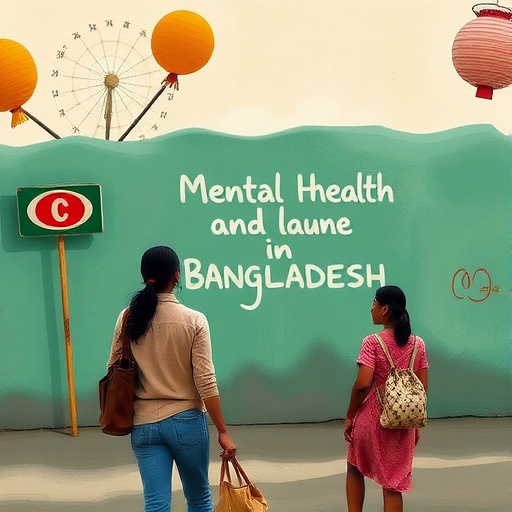In Bangladesh, a country grappling with rapid social and economic changes, mental health remains a critically overlooked aspect of public health. A recent comprehensive study published in BMC Psychiatry illuminates the profound gaps in mental health care seeking behaviors among adults in Bangladesh, revealing striking treatment disparities and identifying key socio-economic determinants influencing these behaviors. The research leverages nationally representative data to provide a detailed picture of the mental health landscape and the acute need for systemic interventions.
The study, anchored on the National Mental Health Survey Bangladesh 2019, encompassed data from 7,270 households, offering an unprecedented national-level insight into patterns of mental health care utilization. Utilizing advanced statistical models – notably both probit and logit regressions – the researchers probed the factors that influence whether individuals seek mental health services. These methodologies are instrumental in estimating the probability of mental healthcare seeking while accounting for various confounding socio-demographic variables.
One of the most alarming findings is the vast treatment gap: approximately 90% of individuals experiencing mental health disorders in Bangladesh do not seek formal mental health care. This staggering statistic underscores an endemic issue that transcends mere access, hinting at deeper social, cultural, and systemic barriers. Among different mental health conditions analyzed, addiction disorders exhibited the highest treatment gap, with 95.24% of affected individuals not receiving care. In contrast, bipolar disorder had the lowest gap, yet still alarmingly high, at 65.63%.
The investigation further reveals that traditional socio-economic variables such as gender, age, marital status, religion, education level, household size, and urban or rural residence generally do not significantly predict mental health service utilization at the population level. Instead, the presence of a family member with a mental disorder emerges as the paramount determinant positively influencing the likelihood that other family members will seek care. This suggests that direct exposure to mental health issues within the family sensitizes and motivates individuals toward treatment-seeking behavior.
Quantitative analysis indicates that having a mentally ill family member increases the probability of seeking mental health services by approximately six percent according to both logit and probit models. This insight holds critical implications for designing targeted interventions, emphasizing the role of family dynamics and social networks in mitigating stigma and encouraging therapeutic engagement.
When disaggregating the data by gender, nuanced differences come to light. Marital status and household size appear to influence mental health care-seeking significantly among women and men, respectively. However, other socio-demographic factors lose their predictive power once controlled for the presence of a mentally ill family member, which reinforces the complexity of mental health behaviors in Bangladesh and challenges simplistic explanatory frameworks.
The pervasive treatment gap identified in this study points to an urgent need for comprehensive policy measures. Despite mental health conditions representing a substantial public health burden, the infrastructure and accessibility of mental health services remain insufficient to meet the population’s needs. Current services are grossly underutilized, indicating that expanding mental health service coverage must be paired with initiatives that reduce stigma, improve mental health literacy, and integrate mental health into primary care settings.
This research also sheds light on the limitations of relying solely on socio-demographic characteristics to predict healthcare seeking. It calls for a more nuanced understanding that incorporates familial and social contexts, which may serve as catalysts for behavioral change. Public health programs could benefit from involving family members in mental health awareness campaigns and care processes, potentially enhancing early detection and treatment adherence.
Furthermore, the analysis highlights addiction disorders as an area requiring special focus due to its exceptionally high treatment gap. Addressing substance abuse issues through culturally appropriate interventions, enhanced community-based support, and linkage with mental health services may be pivotal in reducing the overall treatment gap and improving population health outcomes.
The application of both probit and logit models, yielding consistent results, strengthens the study’s validity and suggests robustness in these statistical approaches for mental health research in low- and middle-income countries. These quantitative techniques help disentangle complex relationships between socio-economic variables and health-seeking behaviors, a methodological advantage for future research aiming to inform evidence-based policy.
In sum, this study offers a sobering portrait of mental health care disparities in Bangladesh, emphasizing that the majority of individuals with mental disorders remain untreated. The findings advocate for a paradigm shift toward inclusive, family-centered, and socially sensitive mental health strategies that are critical to closing the existing treatment gaps. Without such focused efforts, the mental health crisis in Bangladesh is poised to worsen amid ongoing demographic and epidemiological transitions.
As governments and non-governmental organizations monitor this data, the imperative to augment mental health infrastructure and promote service utilization becomes clearer. The evidence presented powerfully argues that tackling mental health in Bangladesh requires integrated approaches that address not only clinical symptoms but also the socio-cultural dimensions influencing care-seeking behavior. Only with such multidimensional strategies can the nation hope to bridge the mental health treatment divide.
Ultimately, this landmark study marks a pivotal step toward enhancing mental health policy and practice in Bangladesh. By revealing the hidden barriers and enablers of mental health service utilization, it lays the groundwork for targeted interventions and systemic reforms that could transform mental health outcomes for millions of people.
Subject of Research: Mental health care seeking behavior and treatment gaps in the adult population of Bangladesh.
Article Title: Mental health care seeking behavior in Bangladesh: determinants and treatment gaps.
Article References:
Huque, R., Azad, A.K., Islam, K. et al. Mental health care seeking behavior in Bangladesh: determinants and treatment gaps. BMC Psychiatry 25, 779 (2025). https://doi.org/10.1186/s12888-025-06813-4
Image Credits: AI Generated




